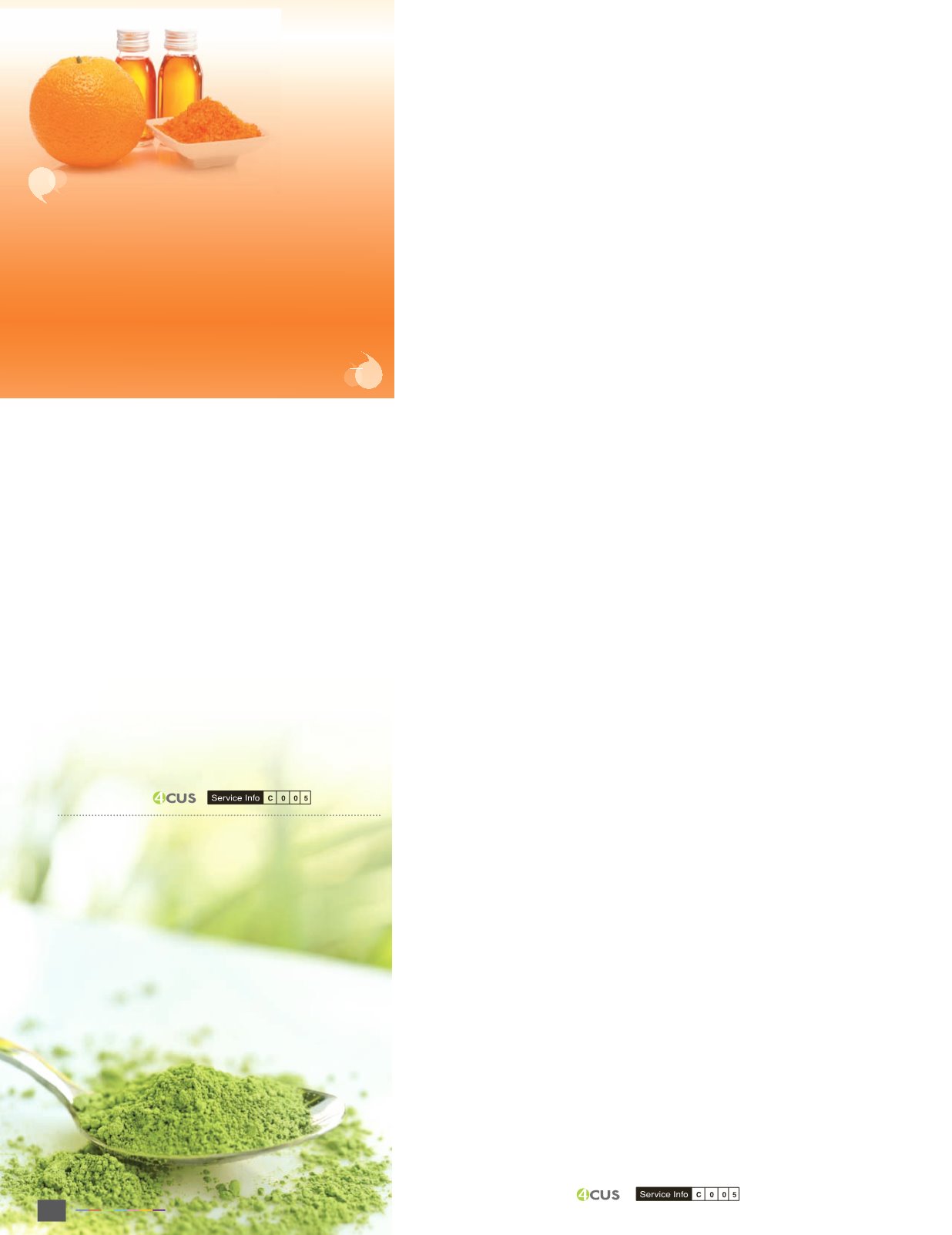
Food Focus Thailand
JULY 2013
40
8. ส
วนปร ะกอบสำคั
ญโ ดยปร ะมาณเ ป
นร
อยละของ
น้
ำหนั
กเรี
ยงจากมากไปหาน
อย
9. วิ
ธี
การใช
คำแนะนำสำหรั
บการเลื
อกใช
สี
ผสมอาหาร
สี
ผสมอาหารถ
าใช
ไม
ถู
กต
องก็
กลั
บเป
นโทษแก
ร
างกายได
สี
ที่
ได
จากธรรมชาติ
เป
นสี
ที่
ใช
ได
ปลอดภั
ยที่
สุ
ด ส
วนสี
สั
งเคราะห
มี
อั
นตรายต
อชี
วิ
ตมากกว
าสี
ประเภทอื่
นๆ จากการที่
สี
สั
งเคราะห
ทุ
กชนิ
ดเป
นสารที่
ไม
มี
ประโยชน
หรื
อไม
มี
คุ
ณค
าทางอาหาร
ต
อร
างกาย หากรั
บประทานอาหารที่
มี
สี
สั
งเคราะห
บ
อยๆ สี
จะ
สะสมอยู
ในร
างกายมากขึ้
น เมื่
อมี
สี
สั
งเคราะห
สะสมอยู
ในร
างกาย
มากพอก็
จะก
อให
เกิ
ดอั
นตรายแก
เราหรื
อผู
บริ
โภคได
แต
ถ
าหาก
ต
องการใช
สี
สั
งเคราะห
จะต
องใช
แต
น
อยและปริ
มาณจำกั
ด
โดยทั่
วไปแล
วจะจำกั
ดปริ
มาณที่
ให
ใช
โดยปลอดภั
ยไว
ไม
เกิ
น 1 มิ
ลลิ
กรั
ม ต
อน้
ำหนั
กร
างกาย 1 กิ
โลกรั
ม ต
อ 1 วั
น
ซึ่
งถื
อได
ว
าเป
นปริ
มาณที่
น
อยมาก (จุ
ไรรั
ตน
เกิ
ดดอนแฝก, 2537)
After arsenic distributes throughout the body, it accumulates in the bones,
muscles, skin, liver and kidney. With arsenic accumulation in the body, it can cause
fatigue, muscle weakness, disorders of the gastrointestinal tract and anemia. Lead
is toxic to the nervous system in both acute and chronic. It could lead to death
within in 1-2 days. Lead causes the chronic poisoning symptoms; found dark bluish
blood line on gums, limp hands and feet, paralysis, nauseated, mental symptoms.
Tartrazine is a synthetic scene that causes food allergies, such as rash, and can
be carcinogen.
Hazards of Using Dyeing Colours Instead of Food Colouring
If manufacturers use dyeing colours instead of food colouring, it can cause even
more harm to human body. Because dyeing colours consist of high amounts of heavy
metals, some dyes can cause gastric cancer. For example; Sudan red is from a
family of Sudan dyes which range from Sudan 1 to Sudan 4. The Sudan1 gives red
colour, so-called Sudan red. It is used in plastic industry, floor polishing and shoes
polish. Due to its vivid and long lasting characteristic, it is illegally added in to some
food such as sauces or ground chilli.
What Type of Food that Prohibits Food Colouring by Ministry of Public
Health?
• Baby food for infant and children.
• Modified milk and modified milk formula for infant and toddler.
• Supplements for infants and toddlers.
• Fresh and fermented fruits and pickles.
• Meat of all kinds.
• Any type of cooked meat, smoked or dried fish, shrimp and shell
• All types of salted and sweetened, or processed to be as such, meat such as
salted fish/shrimp/oysters, or sweetened fish/shrimp.
• All types of meat which are grilled, baked, steamed or fried such as fried
chicken or grilled pork
• Sour or sweet pork/chicken, pork/chicken sausage, all kind of meatballs, fried
fish balls or shrimp paste
• Rice crackers like prawn crackers, fish cracker or crackers in different ways.
• Instant noodles, rice noodles and the dumplings, spaghetti and macaroni.
• Curry paste
Protect Yourself from Dangerous Food Colourings
If you need to mix food colouring, in order to ensure safety and to prevent damage
occurrence, you should know how to choose the right type. By observing the text
on the label, which must be prepared in Thai and gives clear instruction as bellows
messages;
1. Term of use “food colouring”
2. Common colour names
3. Registered number of colours
4. Gross weight or content in metric system. In the case of a powder colours,
use “gross weight” and liquid or very thick liquid, use “gross volume”
5. Manufactured, expiration or best before dates
6. Name and address of the manufacturer or packer for distribution
7. Colour origins, species of plant, vegetable or fruits, or animal
8. Main ingredients, in estimate integral percentage of weight by sort
descending
9. Instruction
Guidelines to Choose the Food Colouring
In case of misused, it returns a negative symptom to the body. The natural colour
is the safest colour to use. The synthetic colours are most harmful when compared
to other types. Basically, these synthetic chemicals give no nutrition’s or benefits to
our body. When regularly taking, these chemicals are accumulated in body. After
our body collects them to an extent, they cause harms to our body. If you need to
use synthetic colours, it could be better used at the minimum level and/or limited
amount.
Typically, safety use is limited to be less than 1 mg per 1 kg of body weight per
day. This is considered a very small amount (Churarat Kerd-don-faek, 1994).
เอกสารอ
างอิ
ง/References
Sitima Jittinandana “Food additives & Seasoning Substances: Colour
for foods” Mahidol University, 17-19.
The risk assessment of food colouringmix of students in urban and
rural areas of the province Surat Thani. Of food consumption.
Journal of Toxicology Thailand. 2552; 24 (1):37-46.
Preservatives & disease in children. Child and Adolescent
Psychiatric Society of Thailand. [Online]:http://www.rcpsycht.org/
cap/article_pp.php
E-Number [online]:http://curezone.com/foods/enumbers.asp
E-Number-Wikipedia [on line]:
-
number.date 04/04/2013
Food colour [online]:http://www.foodnetworksolution.com/wiki/word/
2950/food-colour
Healthy –eating [online]:http://www.thedailygreen.com/healthy-
eating/eat-safe/artificial-food-colourings-health-effects#ixzz2PNZO
c0C6 (07 /05/2013).
Laws that Protect Consumers
• The Notification of the Ministry of Public
Health (No. 281) B.E. 2547 (2004)
regarding food additives which range from
food colourings, food additives, flavours
enhancers and any objects to maintain the
food quality standards
• Directive 84/36/EC, the EU regulations
on allowance of the use of food colouring.


